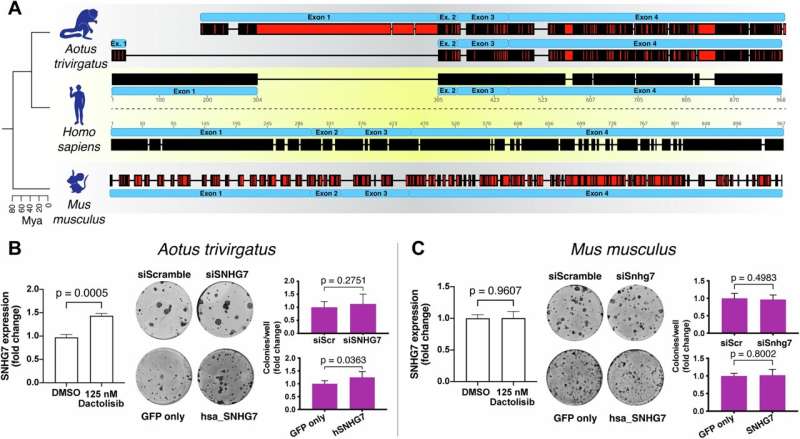This article has been reviewed according to Science X's editorial process and policies. Editors have highlighted the following attributes while ensuring the content's credibility:
fact-checked
peer-reviewed publication
trusted source
proofread
Role of long noncoding RNAs in skin provides important insights for evolution

A study has shown that a type of non-coding RNA molecule could play a role in the development of skin diseases—like eczema or psoriasis—and highlights an important molecular mechanism for driving genetic evolution.
The study by King's College London researchers, published in the EMBO Journal, has revealed a role for long non-coding RNAs in the control of the balance between stem cells versus specialized skin cells in the outer layer of the skin.
After identifying this mechanism in human skin cells, the team didn't see the same effect in a skin cell line isolated from monkeys, a closely related species. These results give important indications as to how 'non-coding' sequences of genetic material can contribute to the evolution of new functions in the genome over short evolutionary timeframes.
On the surface of the skin—known as the epidermis—stem cells either divide to create a clone of themselves, or they transform and develop into specialized skin cells—called corneocytes—that insulate our body from the outside environment.
To maintain the right balance between the number of stem and specialized cells, the process of deciding whether a stem cell divides or commits to becoming a corneocyte is strictly regulated. When this balance is off, it can lead to the development of skin diseases such as eczema or psoriasis.
The study from the Watt Lab at King's looked at one group of genes, called snoRNA Host Genes (SNHGs), that are important in controlling this balance.
SNHGs create molecules of long non-coding RNA. While RNA is best known as the molecule that provides instructions for creating proteins from DNA, non-coding RNA molecules do not directly create proteins. Instead, they have other functions within cells, like modifying other RNA molecules and influencing how much of other RNAs or proteins are produced.
Specifically, in this study the team saw that SNHGs instruct stem cells in the epidermis to divide more, while preventing them from transforming into corneocytes. In an analysis of models of human skin cells, the team found that levels of SNHG production were different between the areas affected by atopic dermatitis (eczema) or psoriasis and the surrounding unaffected skin in the same person.
The results could indicate that these molecules contribute to the skin alterations seen in these inflammatory conditions. The study also revealed important insights about the evolution of the genome, after identical testing in vitro found that one of these RNAs—SNHG7—had no impact on a skin cell line isolated from a species of monkey.
"This means that SNHGs can sometimes go 'suddenly' (in evolutionary terms) from being inert to active in the cell. This could be a powerful driver in developing new biological features during evolution," says Dr. Matteo Vietri Rudan.
A major question within molecular and evolutionary biology has been understanding how exactly a genome changes to acquire new functions during evolution, and the study highlights the role that these non-coding segments of the genome could play in this.
The authors hope that further research into the way SNHGs work at the molecular level and investigation of their effects in other biological processes, for example during development, will shed more light on how, and to what extent, non-coding sequences can contribute to the evolution of new traits across species and to their adaptation to changing environments.
More information: Matteo Vietri Rudan et al, Neutral evolution of snoRNA Host Gene long non-coding RNA affects cell fate control, The EMBO Journal (2024). DOI: 10.1038/s44318-024-00172-8
Journal information: EMBO Journal
Provided by King's College London

















